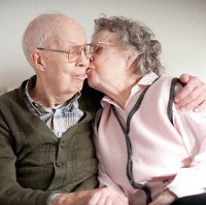
Our intentions are good. All of us in the senior and home care realm are working to change and improve the experience for seniors, and certainly do not want to contribute to anything that detracts from their quality of life. Now LeadingAge has launched a national effort to ‘conquer ageism.’ It’s a monumental effort we hope will gain fast traction.
Ageism surrounds us – we need to look no further than the birthday card aisle and this year’s Oscar nominees to see proof. But we need to also examine our own actions and language.
Here’s how we may be inadvertently contributing to ageism:
- “Sweetie, Honey, Dear”: These may sound like endearing terms but they are actually very patronizing and reduce a person to trite terms. When we use these terms, we are often ‘not seeing’ the full person with all his or her hopes, dreams, experiences, identity, wisdom, purpose and passion – core elements of who we are that remain with us throughout our lives, growing richer as we age. According to a Next Avenue blog by Debbie Reslock, ‘everyone agrees this behavior is not intended to hurt anyone’ but . . . it does when it makes people feel like they are invisible.
Patty Crawford, MA, Manager for Augustana Open Circle in Apple Valley, Minnesota, shares that ‘older people tell me it feels like they disappear in the eyes of people around them . . . My work at Augustana Open Circle made me realize we must always support identity and dignity.” Patty is also the presenter of ElderSpeak and Identity Subversion, a presentation developed to help senior and health care providers tackle the leadership challenge of ageism in elder services.
- ‘Over the Hill’ celebrations: Birthday cards and celebrations that tag people as ‘over the hill’ contribute to the notions that growing older is bad and something to avoid. Again, the intent seems harmless but those party themes, cards and words denigrate the value that our elders bring to our communities. Instead, how can we change the image of aging to a badge of honor, recognizing all the value, experiences, and richness seniors bring to our world?
- Still using the word ‘Still’?: The next time you are talking about an inspiring older person, pause to reflect on whether you are using the word ‘still.’ Dr. Bill Thomas reminds us that while we may not mean to, we are often actually patronizing people – ‘Mary is still driving.’ We don’t say that about a 50-year-old and we shouldn’t be saying it about an 85-year-old. What about ‘she still plays golf, goes skiing, dances, _________ – fill in the blank. Dr. Thomas, the founder of the Eden Alternative and the Greenhouse Project, has been working to change aging for decades. He reminds us: watch our language as well as our actions.
- Assuming seniors need help: Before you reach to automatically carry something for that senior, check first. Debbie Reslock’s Next Avenue blog also shares feedback from Judy Jellison Graves, age 73, who says “she uses a cane but is very self-sufficient. ‘It’s annoying when people feel like I need something I have no problem doing myself.’” And from my own personal experience living with my 92-year-old mother-in-law who still drives, I’ve learned that my polite offer to help carry in groceries is no match for her delight in doing it herself. [Did you catch the ‘still’ in this bullet? That’s how easy it slips into our language . . . I’m working on catching myself before I use ‘still’ again.]
- Neglecting the senior in the room: Kathy Christians, RN, Director of Life Care Integration for Lifespark stresses that far too often she hears from Twin Cities seniors that in the doctor’s office or other elder care providers, the professionals may talk directly to the adult child about the senior as if they weren’t even in the room. “That’s easy to fix and just requires that all of us develop a higher sensitivity and awareness of our own actions. Small changes start with little efforts like these. While they may seem simple, they have far-reaching impact,” Kathy stressed.
So let’s give ageism the kick it deserves and start to work more consciously to offer the seniors we serve the autonomy they desire and have earned.
Note. At Lifespark, we use the term ‘seniors’ because unfortunately no one searches for services for ‘people in the second half of life.’ But we’re hopeful that will change in the future.
And we meanwhile keep pushing the efforts to truly see each senior for who he or she is . . .



